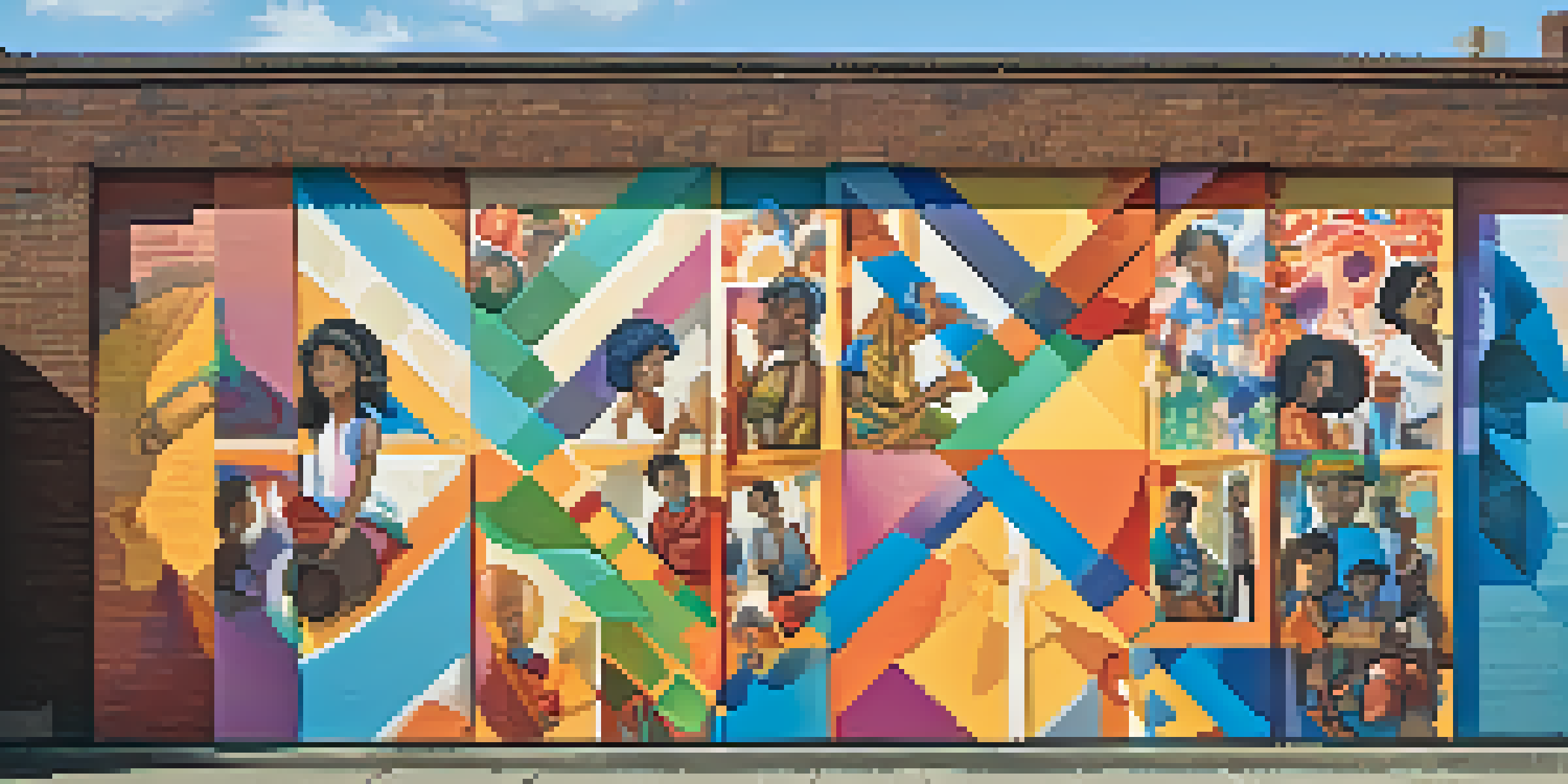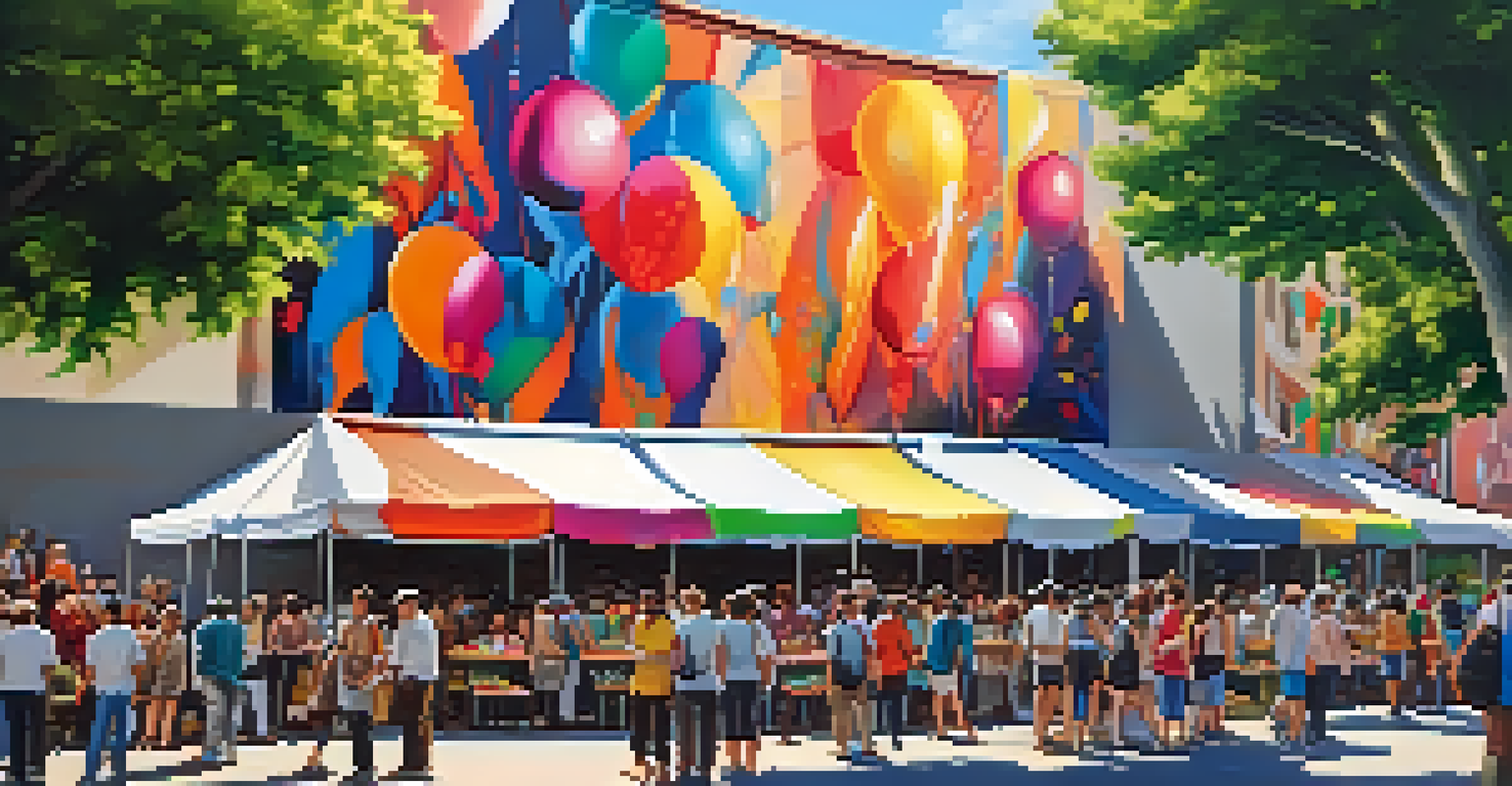The Evolution of Street Art and Graffiti Over the Years

Understanding the Roots of Street Art and Graffiti
Street art and graffiti have roots that delve deep into urban culture, with origins dating back to ancient civilizations. From cave paintings to ancient Greek inscriptions, the desire to express oneself visually has always existed. Fast forward to the 20th century, and we see these forms evolving in the streets of cities like New York and Philadelphia, where early graffiti began to emerge as a way for marginalized voices to be heard.
Art is not what you see, but what you make others see.
During the 1960s and 1970s, graffiti became a prominent form of expression in urban settings, often tied to social and political movements. Artists used spray paint to convey powerful messages about identity, race, and inequality, making their mark on the urban landscape. It was more than just vandalism; it was an art form that challenged the status quo and sparked conversations in communities.
Understanding these roots is essential to appreciating the complexities of street art today. It serves as a reminder of how these mediums have transformed from simple tags into elaborate murals that can beautify entire neighborhoods. As we explore the evolution of street art and graffiti, it becomes clear that they are not just visual expressions but cultural movements that reflect society's values and struggles.
The Rise of Graffiti in the 1980s and 1990s
The 1980s marked a significant turning point for graffiti, as it gained mainstream attention and recognition. Influential artists like Jean-Michel Basquiat and Keith Haring brought graffiti into galleries, bridging the gap between street art and the fine art world. This crossover not only legitimized the art form but also inspired a new generation of artists to explore their creativity on walls instead of canvases.

During this era, graffiti became synonymous with hip-hop culture, promoting a sense of community and identity among urban youth. It was a form of rebellion, with artists using vibrant colors and bold styles to convey their messages. The streets transformed into galleries, with murals telling stories of struggle, hope, and resilience, captivating the public's attention.
Social Commentary Through Art
Modern street art serves as a powerful platform for addressing pressing social issues, inviting community engagement and dialogue.
However, this newfound popularity also led to increased scrutiny and legal battles. Cities began to crack down on graffiti, labeling it as vandalism. This tension between artistic expression and legality sparked debates about the ownership of public space and the role of art in society, setting the stage for future discussions about street art.
Street Art as a Tool for Social Commentary
As street art evolved, it increasingly became a platform for social commentary, addressing issues like inequality, climate change, and political unrest. Artists like Banksy and Shepard Fairey use their work to provoke thought and inspire action, transforming the streets into a canvas for societal reflection. Their murals often carry layered meanings that invite viewers to engage in conversation and contemplation.
The streets are the canvas of the people, and every mural tells a story.
These powerful pieces can be found in cities around the world, drawing attention to pressing issues while beautifying urban spaces. Street art has the ability to reach a diverse audience, making complex topics accessible to people from all walks of life. It's not just about aesthetics; it's about making a statement and igniting change.
The impact of street art as a form of social commentary is significant, as it encourages community involvement and awareness. Many artists collaborate with local organizations to address specific issues within their communities, proving that art can indeed make a difference. This evolution highlights the importance of street art in today's society, where the walls speak volumes.
The Influence of Technology on Street Art
With the advent of technology, street art has taken on new dimensions, expanding its reach and impact. Digital tools enable artists to create and share their work in innovative ways, from virtual reality murals to augmented reality experiences that bring static art to life. This fusion of technology and art allows for greater experimentation and creativity.
Social media platforms like Instagram have also played a pivotal role in the evolution of street art. Artists can now share their work with a global audience instantly, gaining recognition and followers beyond their local communities. This visibility has led to collaborative projects and opportunities that were once unimaginable, connecting artists across borders.
Technology's Role in Evolution
The integration of technology and social media has transformed street art, expanding its reach and raising questions about authenticity and commercialization.
However, this shift also raises questions about authenticity and commercialization. As street art becomes more mainstream, some artists grapple with the balance between staying true to their roots and embracing new opportunities. The influence of technology on street art is undeniable, as it continues to shape the narrative and redefine what it means to be a street artist in the modern age.
Street Art Festivals and Community Engagement
In recent years, street art festivals have emerged as a celebration of creativity and community, bringing together artists and art lovers alike. Events like Wynwood Walls in Miami and the Mural Festival in Montreal showcase the talents of local and international artists, transforming public spaces into vibrant outdoor galleries. These festivals not only beautify neighborhoods but also foster a sense of pride and ownership among residents.
Community engagement is at the heart of many street art initiatives, as artists collaborate with locals to create murals that reflect their unique stories and histories. This participatory approach helps to build connections within communities, creating a platform for dialogue and understanding. It’s a beautiful way to honor the past while envisioning a brighter future through art.
These festivals often include workshops and panels, providing opportunities for aspiring artists to learn from established professionals. By nurturing talent and encouraging collaboration, street art festivals contribute to the growth of the art form while strengthening community bonds. They remind us that art is not just about the artist but also about the people it touches.
Globalization and the Spread of Street Art
The globalization of street art has led to a rich tapestry of styles and influences, as artists share ideas and techniques across cultures. What was once a localized phenomenon has now become a global movement, with street art festivals and exhibitions popping up in cities around the world. This cross-pollination of styles enriches the art form, as artists draw inspiration from diverse backgrounds and experiences.
As street art gains popularity globally, it also faces challenges related to cultural appropriation. Artists must navigate the fine line between drawing inspiration from different cultures and respecting their significance. This conversation is essential in ensuring that street art remains a genuine reflection of its roots while embracing new influences.
Street Art's Deep Cultural Roots
Street art and graffiti have evolved from ancient forms of expression into vital cultural movements reflecting societal values and struggles.
Moreover, the rise of social media has accelerated the spread of street art, allowing artists to showcase their work to a global audience instantly. This interconnectedness fosters a sense of community among artists and art lovers, transcending geographical boundaries. The globalization of street art highlights the power of art to unite people, creating a shared narrative that celebrates diversity.
The Future of Street Art: Trends and Innovations
Looking ahead, the future of street art is brimming with possibilities as artists continue to push boundaries and explore new mediums. We can expect to see more interactive and immersive installations that engage audiences in unique ways, blurring the lines between art and experience. Innovations in technology, such as projection mapping and 3D printing, will likely play a significant role in shaping the next generation of street art.
Sustainability is also becoming a vital concern for many artists, as they seek eco-friendly materials and practices to minimize their environmental impact. This shift towards green art not only reflects a growing awareness of climate issues but also resonates with audiences who value sustainability. Artists are finding creative ways to incorporate these principles into their work, ensuring that street art remains relevant in an ever-changing world.

As street art continues to evolve, its ability to inspire, provoke thought, and foster community remains steadfast. The future holds exciting opportunities for artists to explore new themes and ideas, ensuring that street art remains a dynamic and essential part of urban culture. With every mural and installation, artists will continue to leave their mark on the world, inviting us to engage, reflect, and celebrate the beauty of public art.